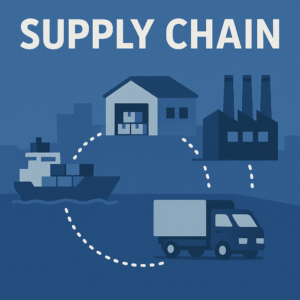
Accounts Payable
The amount a company owes to suppliers for goods they have previously received.
Accounts Receivable
The amount a customer owes to a business for orders paid for using credit.
Active Inventory
Goods which have been sold within a timeframe.
Active Stock
Inventory waiting in a distribution area to be sent to a customer.
Backorder
An order for an item which is out-of-stock.
Benchmarking
The measurement of goods and services against other market leaders.
Bill of Lading
An agreement between shipper and carrier. Once signed, the carrier must transport the cargo named in the agreement.
Bottleneck
A point in a supply chain which disrupts the flow of inventory, causing delays.
Carrier
A party who moves goods from one desired place to another.
Carrying Costs
The amount it costs to hold and store inventory.
Cross-Docking
The process of loading recently incoming goods into outgoing shipping vehicles, reducing the temporary holding time of cargo.
Dead Stock
Inventory which is no longer in demand and is unlikely to be sold in the near future.
Demand Planning
A process of projecting future demand and ensuring enough inventory is available to meet user requirements.
Distribution Center
A property which holds inventory prior to delivery.
Distribution
The process of delivering goods to users and customers.
First-in, First-out
The principle in which the stock which was first received by a distribution center or warehouse, is the first to be dispatched, thus reducing hold time.
Free Time
The time allotted to load or unload cargo in a port.
Freight Forwarder
A third-party who co-ordinates shipments for other companies and businesses.
Import License
An official permit from a government which allows companies to move goods into a country.
Inventory Control
Maintaining a minimum amount of stock to meet customer demands while keeping holding costs as low as possible.
Inventory Management
The processes of storing and maintaining cargo in a warehouse
or distribution center.
Just-in-Time (JIT)
A strategy of ensuring goods arrive at the exact time they are needed and minimizing inventory hold time.
Last-Mile Delivery
The last stage of a delivery process whereby a product is moved from a distribution center to the customer.
Lead Time
The total time needed to meet demand and deliver a product.
Logistics
The necessary steps required to meet user specifications.
Manufacturer
The original creator of a product for sale.
Materials Requirements Planning
The process of determining the materials and components needed for goods assembly and meeting demand.
On-time, In-Full (OTIF)
A metric which states how many deliveries made by a company were delivered at the necessary time and in their complete capacity.
Procurement
The acquisition of inventory.
Quality Control
The process of ensuring that stock is of high quality and meets customer expectations and uses.
Reverse Logistics
The process of returning goods from the customer to the original distribution.
Routing
The process of optimally planning the movement of goods in order to maximize the efficiency of inventory circulation.
Supply Chain Management
The overarching philosophies which control the holding, distribution, and processing of goods and products from the stock stage to customer receipt.
Third-Party Logistics (3PL)
A company which provides logistics services such as item storage, shipping, delivery, receiving, and inventory management.
Value Chain
The steps which go into creating a product, from design to delivery.
Warehouse
A property used to house cargo and material.

